国家产业政策对煤炭工业的影响1
煤炭行业的历史演变及政策影响
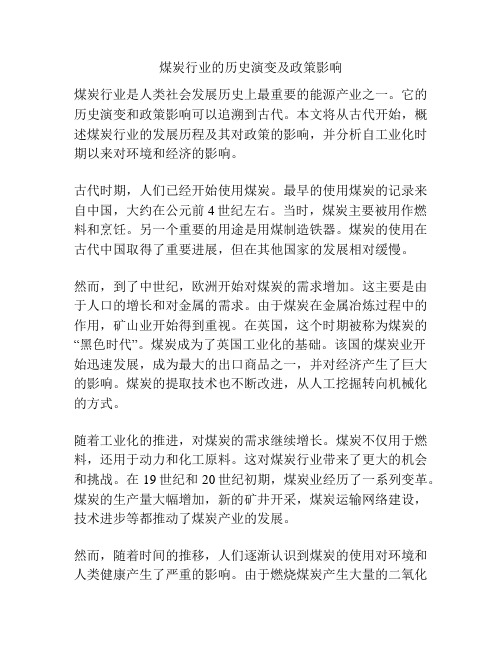
煤炭行业的历史演变及政策影响煤炭行业是人类社会发展历史上最重要的能源产业之一。
它的历史演变和政策影响可以追溯到古代。
本文将从古代开始,概述煤炭行业的发展历程及其对政策的影响,并分析自工业化时期以来对环境和经济的影响。
古代时期,人们已经开始使用煤炭。
最早的使用煤炭的记录来自中国,大约在公元前4世纪左右。
当时,煤炭主要被用作燃料和烹饪。
另一个重要的用途是用煤制造铁器。
煤炭的使用在古代中国取得了重要进展,但在其他国家的发展相对缓慢。
然而,到了中世纪,欧洲开始对煤炭的需求增加。
这主要是由于人口的增长和对金属的需求。
由于煤炭在金属冶炼过程中的作用,矿山业开始得到重视。
在英国,这个时期被称为煤炭的“黑色时代”。
煤炭成为了英国工业化的基础。
该国的煤炭业开始迅速发展,成为最大的出口商品之一,并对经济产生了巨大的影响。
煤炭的提取技术也不断改进,从人工挖掘转向机械化的方式。
随着工业化的推进,对煤炭的需求继续增长。
煤炭不仅用于燃料,还用于动力和化工原料。
这对煤炭行业带来了更大的机会和挑战。
在19世纪和20世纪初期,煤炭业经历了一系列变革。
煤炭的生产量大幅增加,新的矿井开采,煤炭运输网络建设,技术进步等都推动了煤炭产业的发展。
然而,随着时间的推移,人们逐渐认识到煤炭的使用对环境和人类健康产生了严重的影响。
由于燃烧煤炭产生大量的二氧化碳等温室气体,对气候变化产生重要影响。
此外,煤炭的燃烧还释放大量的污染物,例如二氧化硫和氮氧化物。
这些污染物对空气质量和人类健康造成了严重危害。
为了应对这些问题,各国纷纷采取了政策措施来减少对煤炭的依赖和降低对环境的负面影响。
其中最具代表性的是《京都议定书》,该协定要求发达国家减少温室气体排放。
这间接推动了对煤炭依赖的减少。
许多国家也开始逐步淘汰高排放的老旧火力发电厂,加大对清洁能源的支持,以减少对煤炭的需求。
然而,煤炭行业仍然面临挑战。
在中国、印度等快速发展的经济体中,煤炭需求仍然很大,导致煤炭市场的发展仍然非常活跃。
现行自主创新税收优惠政策对煤炭企业技术创新的影响及对策

业管理 , 构建新 的煤炭工业体系的相关政策和措施 。国务院关 于促进煤炭工业健康发展 的若干 意见 ,进一 步确立 了煤 炭在 我 国能源工业 中的主体地位 ,指 明了今后一个 时期煤 炭工业
的发展方 向。国务 院在 山西省开展煤炭工业 可持续 发展 政策
ห้องสมุดไป่ตู้
取得上述成绩 的同时 ,煤炭企业技术创新仍 存在 一些问
1 煤炭 行业 技术创 新 能力现 状
长期以来 ,煤炭行业健康 发展一直受到 了国家高度 重视 和社会 的广泛关注。煤炭科 技进 步加快 , 一个 以煤炭企业为主 体, 科研机构和大专 院校为 中坚 力量 , 社会 广泛 参与 、 国内外 合作 的“ 产学研 ” 一体化 的行业科技创 新体 系正 在逐步形 成 。 20 0 6年原国有重点煤矿采煤机械化 水平 达到 8 .%,工作 面 64 单 产 4 57吨 / ・ , 69 个 月 同比提 高了 2 4 。2 0 , 6 9吨 0 6年 安全高 效 矿井 2 l , 2 处 煤炭 产量 70 亿 吨 , .5 人均效率超过 l , , 8吨 工 单 井利 润 1 7亿元 , . 5 百万 吨死亡 率 o0 7 主要经 济技 术指标 . , 6
3 不 断 深化煤炭 行 业税 费管理 制度 改革 。逐 步建 立 起科 学合理 的煤炭 税 费制 度
国务 院关于促进煤炭工业健康发展 的若 干意见中明确提 出了要 “ 切实落实 中央财政对 国有重点煤矿 定额返还 和所 得
税返还政策 , 加快煤炭税费制度 改革 步伐 , 把煤矿 企业税 负降 到合理水平 ,落实对 已公布取消 的鲁类基金 和收费项 目的清 理、 整顿措施 , 减轻煤炭企业负担” 。近年来 , 有关部 门集 中调
煤炭行业经济影响因素分析

煤炭行业的发展对于促进地 区经济发展、增加就业机会
等方面具有积极作用。
煤炭行业的可持续发展对于 环境保护和生态平衡具有重
要意义。
煤炭行业的现状
煤炭是全球最重 要的能源之一, 广泛应用于发电、 钢铁、化工等领
域。
煤炭行业在过去 几十年中经历了 快速的发展和变 化,但随着环保 政策的实施和可 再生能源的发展, 煤炭行业正面临 着巨大的挑战。
PART 1
煤炭行业概述
煤炭行业的发展历程
煤炭开采历史悠久,最早可追溯 到古代
20世纪初,石油和天然气的兴起 对煤炭行业产生冲击
添加标题
添加标题
添加标题
添加标题
工业革命时期,煤炭成为主要能 源
近年来,环保政策和可再生能源 的发展对煤炭行业产生影响
煤炭行业的重要性
煤炭行业在能源结构中占据 重要地位,对于保障国家能 源安全具有重要意义。
资源应对策略
优化资源配置:提高煤炭资源 利用效率,降低成本
技术创新:研发新技术,提高 煤炭开采效率和安全性
政策支持:争取政府政策支持, 降低税收和行政费用
市场拓展:扩大煤炭销售市场, 提高市场份额和竞争力
技术应对策略
提高煤炭开采效率:采用先进的 开采技术和设备,提高煤炭产量 和质量
提高能源利用效率:加强能源管 理和节能技术研发,提高能源利 用效率
煤炭行业的竞争 非常激烈,企业 需要不断提高生 产效率、降低成 本、提高产品质 量才能保持竞争
力。
煤炭行业在许多 国家和地区都面 临着去产能、转 型升级的压力, 需要寻找新的发 展模式和方向。
PART 2
煤炭行业经济影响因素分析
我国煤炭产业政策发展及历史讲解
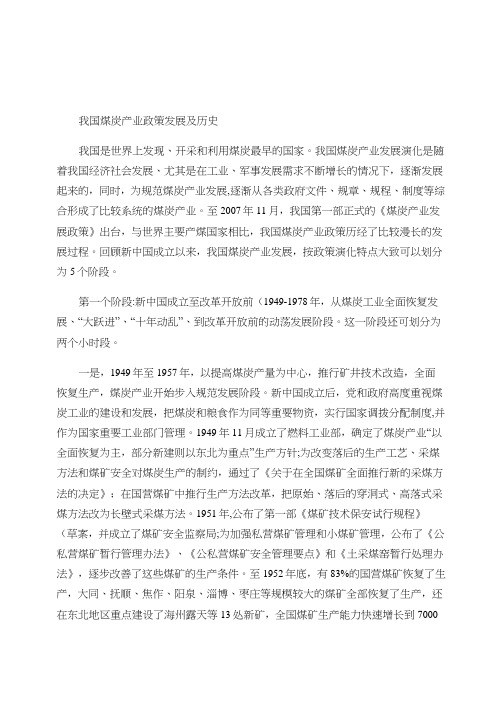
我国煤炭产业政策发展及历史我国是世界上发现、开采和利用煤炭最早的国家。
我国煤炭产业发展演化是随着我国经济社会发展、尤其是在工业、军事发展需求不断增长的情况下,逐渐发展起来的,同时,为规范煤炭产业发展,逐渐从各类政府文件、规章、规程、制度等综合形成了比较系统的煤炭产业。
至2007年11月,我国第一部正式的《煤炭产业发展政策》出台,与世界主要产煤国家相比,我国煤炭产业政策历经了比较漫长的发展过程。
回顾新中国成立以来,我国煤炭产业发展,按政策演化特点大致可以划分为5个阶段。
第一个阶段:新中国成立至改革开放前(1949-1978年,从煤炭工业全面恢复发展、“大跃进”、“十年动乱”、到改革开放前的动荡发展阶段。
这一阶段还可划分为两个小时段。
一是,1949年至1957年,以提高煤炭产量为中心,推行矿井技术改造,全面恢复生产,煤炭产业开始步入规范发展阶段。
新中国成立后,党和政府高度重视煤炭工业的建设和发展,把煤炭和粮食作为同等重要物资,实行国家调拨分配制度,并作为国家重要工业部门管理。
1949年11月成立了燃料工业部,确定了煤炭产业“以全面恢复为主,部分新建则以东北为重点”生产方针;为改变落后的生产工艺、采煤方法和煤矿安全对煤炭生产的制约,通过了《关于在全国煤矿全面推行新的采煤方法的决定》;在国营煤矿中推行生产方法改革,把原始、落后的穿洞式、高落式采煤方法改为长壁式采煤方法。
1951年,公布了第一部《煤矿技术保安试行规程》(草案,并成立了煤矿安全监察局;为加强私营煤矿管理和小煤矿管理,公布了《公私营煤矿暂行管理办法》、《公私营煤矿安全管理要点》和《土采煤窑暂行处理办法》,逐步改善了这些煤矿的生产条件。
至1952年底,有83%的国营煤矿恢复了生产,大同、抚顺、焦作、阳泉、淄博、枣庄等规模较大的煤矿全部恢复了生产,还在东北地区重点建设了海州露天等13处新矿,全国煤矿生产能力快速增长到7000万吨。
1953年,随着我国大规模的经济建设,为保证钢铁工业对炼焦洗精煤需要,解决全国工业生产布局、国防上的不合理状况,提出“把基本建设放在首位”,重点扩建了开滦等15个老矿区,并开始平顶山、潞安等10新矿区的建设;发现了淮北的宿蒙、山东肥城、济宁、滕县等一批储量丰富、开发条件好的新煤田。
山西煤炭企业的转型发展
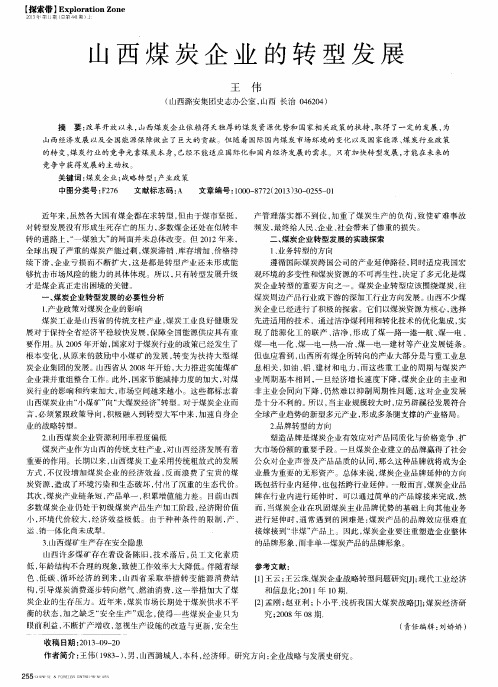
2 . 山西煤炭企业资源利用率程度偏低
煤炭产业作为山西的传统支柱产业 , 对 山西 经济发展有着 重要的作用 。长期以来 , 山西煤炭 业 采用 传统粗放式的发展 方式 , 不仅没增加煤 炭企业 的经 济效益 , 反 而浪费 了宝 贵的煤
炭资源 , 造成 了环境 污染 和生态破 坏 , 付 m了沉重 的生 态代价 。 其次 , 煤 炭产业链 条短 , 产 品单一 , 积 累增值能力差。 目前 山西 多数煤炭企业仍处于初级煤炭产 品生产加工 阶段 , 经济附价值 小, 环境代价较 大 , 经 济效益极低 。由于种种 条件 的限制 , 产、
才是 煤 企 真 正 走 出 困境 的关 键 。
一
产管理落 实都不到位 , 加 重了煤炭生 产的负荷 , 致使矿 难事故
频发 , 最终给人 民、 企业 、 社 会 带来 了惨 重 的损 失 。 二、 煤 炭 企 业 转 型 发 展 的 实 践探 索 1 、 业 务 转 型 的 方 向
遵循 国际煤炭跨 国公 司的产业延伸路径 , 同时适应我 国宏 观环境 的多变性 和煤炭 资源 的不 可再 生性 , 决定 了多元化是煤 炭企业转 型的重要方 向之一 。煤 炭企业转 型应该 围绕煤 炭 , 往 煤炭周边产品行业 或下游 的深加 : 行业方向发展 。山西不少煤 炭企业 已经进行 了积极 的探索 。它们 以煤 炭资源为核心 , 选择 先进适用 的技术 ,通过 洁净煤利用 和转化技 术的优 化集成 , 实 现 了能源化 工的联产 、 洁净 , 形 成 了煤一 路一 港一航 、 煤一 电 、 煤一 电一化 、 煤一 电一热一冶 、 煤一 电一建 材等产业发展链条 。 但也应看 到 , 山西所有煤企所转 向的产业大部分是与重工业息 息相 关 , 如油、 铝、 建材 和 电力 , 而这些重 工业 的周 期 与煤炭产 业周 期基本相 同 , 一旦 经济增长速 度下降 , 煤炭企业 的主业 和 非主业会 同向下 降 , 仍 然难 以抑制 周期性 问题 , 这 对企业发展 是十分不利 的。 所 以, 当主业规模较大时 , 应另辟蹊径发展 符合 全球产业趋势 的新型多元产业 , 形成多条腿支撑 的产业格局 。 2 . 品牌转型的方向 塑造 品牌 是煤 炭企业有效应 对产品同质化与价格竞争 、 扩 大市场份额 的重要手段。一旦煤炭企业建立 的品牌赢 得了社会 公众对企业声誉及产品品质的认同 , 那 么这种 品牌就将成 为企 业 最为重要的无形资产 。总体来说 , 煤炭企业 品牌延伸 的方 向 既包括行业 内延伸 , 也包括跨行业延伸。一般而言 , 煤炭企业 品 牌在行业 内进行延伸时 ,可 以通过简单的产品嫁接来完成 , 然 而, 当煤炭企业 在巩 固煤 炭主业 品牌优 势的基础 上向其他业务 进行延伸 时 , 通 常遇到 的广 木 I 难是: 煤 炭产 品的品牌效应很难 直
中国煤炭工业的现状和发展趋势分析

中国煤炭工业的现状和发展趋势分析中国是全球最大的煤炭消费国,自然也是煤炭生产国。
随着经济的发展,煤炭工业已成为中国经济的重要支柱之一。
这篇文章将从以下几个方面分析中国煤炭工业的现状和发展趋势。
一、煤炭工业的现状1. 生产规模煤炭工业是中国的支柱产业之一,其生产规模非常庞大。
截至2020年,中国年煤炭产量约为40.05亿吨,同比增长1.4%。
据统计,中国煤炭产量占全球总产量的48.5%,其消费量也占全球总消费量的50%以上。
煤炭工业已经成为中国国内资源产业中最大、最具规模的行业之一。
2. 供需格局煤炭供需格局变化也是当前煤炭工业发展的重要趋势之一。
近年来,因为国家环保政策的严格执行,煤炭产业在产量方面受到了限制,此外,目前中国的能源占比仍有很大的比例是以煤炭为主。
这使得近年来中国煤炭供需关系呈现了供不应求的态势。
数据显示,2018年,中国进口煤炭总量达到超过2亿吨,同比增长3.1%,宽口径铁矿石原矿进口量更是同比增长8.2%,但是这种情况在2019年-2020年逐渐得到了缓解。
3. 前景分析随着国家的“煤改气”政策逐渐深入实施,煤炭工业的前景也有了越来越大的不确定性,一些琳琅满目的新技术和新产业也不断涌现。
可再生能源的时代来临,煤炭作为一种传统的化石燃料将逐渐被淘汰,未来煤炭工业将出现重大变革。
但是,在当前中国工业结构体系中,煤炭工业的地位仍然非常重要,煤炭工业也是国家实施“煤改气”战略的重要一环。
二、煤炭工业发展趋势1. 国际影响中国是全球最大的煤炭消费国,其能源利用和煤炭消费模式对全球的环境和气候等等都有着深远的影响。
随着国际社会对环保和可持续能源的关注增加,中国煤炭工业必须适应新时代的要求,通过科技创新来提高效率和减少污染,进一步实现新旧动能转换。
2. 技术创新科技创新是提高煤炭工业效率、降低成本和减少污染的关键。
中国政府已经加快了对新能源技术、清洁燃料技术等领域的投入,力图提升中国煤炭产业的技术水平,同时,中国煤炭工业也在发挥自身的技术优势,积极探索新的技术应用。
(完整版)我国煤炭行业发展史

关于我国煤炭产业的发展历程及其影响煤炭是我国的主体能源,是国民经济发展的基础产业,我国煤炭能否满足经济增长和社会进步的需要,能否走出一条具有中国特色的煤炭产业可持续发展之路,在相当程度上取决于国家对煤炭实施怎样的产业政策。
所以,我国要借鉴历史经验教训,从现实情况出发,确定煤炭产业的方向和思路,制定相应的配套辅助政策。
由于社会结构的变化,煤炭行业现在也迎来了“互联网+”,现行的“金银岛煤炭”仅是利用互联网的优势,将线下的传统交易方式整合到线上,减少了很多交易成本。
一、我国煤炭产业政策计划经济时期的煤炭产业政策。
49年至80年的计划经济时期,从建国后到80年代之前,我国煤炭行业也像所有其他行业一样,完全在计划经济的环境下运行,所有的煤炭生产任务都由国有企业承担。
企业的建设与发展基本上依赖国家投资,企业的生产、销售、定价完全遵从政府计划。
改革开放初期的煤炭产业政策。
改革开放初期,煤炭工业实施积极的对外开放政策,引进国外先进设备和技术,提高了国有煤矿的整体技术装备水平,推动了煤矿现代化建设。
国家在支持全国乡镇煤矿发展的同时,为了调动煤炭企业和职工的积极性,从1985年开始,又对原国有重点煤矿、国有地方煤矿实行了投入产出总承包,以后又多次延续财务承包。
这些产业政策,对调动地方、农民办矿的积极性和调动国有煤炭企业的积极性,增加煤炭企业的经营活力,促进煤炭生产和供给发挥了重要作用。
向市场经济转型初期的产业政策。
我国1993年以后还没有形成一个比较完整的煤炭产业政策体系。
在向市场经济转型初期(1993年-1998年),国家在支持煤炭企业减人提效,鼓励兴办非煤产业的同时,一方面在煤炭总量开始失控时继续沿用鼓励小煤矿发展的政策,另一方面又在向市场经济转型中急于求成,提出了三年放开煤价、三年抽回补贴、煤炭行业整体“扭亏为盈”的目标;1994年,在由产品税改为增值税的税制改革中,考虑煤炭行业特殊性不足,大大增加了煤炭企业的税收负担,“九五”成为煤炭产业建国以来最困难的时期,原属中央财政的煤炭企业有2/3的企业亏损。
2024年山西省煤炭市场环境分析

2024年山西省煤炭市场环境分析引言本文将对山西省煤炭市场环境进行分析。
首先对山西省的地理位置和煤炭资源进行介绍,然后探讨山西省煤炭市场的特点和发展趋势,最后对市场环境的影响因素进行评估。
山西省概况山西省位于中国北方,东临河北省和山东省,南接河南省和陕西省,西连内蒙古自治区,北靠辽宁省和吉林省。
山西省地处中国煤炭资源丰富的区域,是中国重要的煤炭生产基地之一。
根据统计数据,山西省储量居全国之首,占全国总储量的四分之一以上。
山西省煤炭市场特点1.丰富的煤炭资源:山西省拥有丰富的煤炭资源,包括烟煤、无烟煤、褐煤等多种煤种,品种齐全。
2.历史悠久的煤炭产业:山西省的煤炭产业可追溯到几千年前,拥有丰富的煤炭开采经验和技术。
3.潜力巨大的市场需求:中国是世界上最大的煤炭消费国之一,山西省煤炭市场需求旺盛,尤其是在能源和工业领域。
4.交通便捷的地理位置:山西省地处中国北方,交通便利,可以方便地向周边省市和沿海地区输送煤炭。
山西省煤炭市场发展趋势1.多元化发展:山西省煤炭产业正在朝多元化发展方向转变,将逐步减少对传统煤炭产品的依赖,加大对煤化工、煤电联产等高附加值产品的开发。
2.环保治理:随着环保意识的提高和政府环保政策的实施,山西省将加大煤炭资源的开采和利用过程中的环境保护力度,并推动煤炭行业的绿色发展。
3.科技创新:山西省将加大对煤炭行业科技创新的支持力度,推动技术进步和产业升级,提高煤炭产业的竞争力和可持续发展能力。
市场环境影响因素评估1.政策因素:国家和地方政府的政策对山西省煤炭市场的发展有重要影响,包括煤炭资源管理、环境保护、能源消费结构调整等政策。
2.经济因素:山西省煤炭市场的发展受到经济因素的影响,包括宏观经济环境、工业需求、能源消费结构等。
3.环境因素:山西省的煤炭开采和利用对环境造成影响,环境因素包括能源利用效率、环境污染治理、碳排放等。
4.技术因素:科技创新对山西省煤炭市场的发展起到重要的推动作用,包括煤炭开采技术、煤化工技术、清洁煤技术等。
国家相关政策对煤炭产业发展的影响

国家相关政策对煤炭产业发展的影响四、煤炭产业发展相关政策及其影响(一)国家积极推进煤炭工业健康可持续发展长期以来,煤炭行业健康发展一直受到了国家高度重视和社会的广泛关注。
党中央国务院领导同志多次深入煤矿调查研究,主持召开国务院常务会议专题研究煤炭工业发展和安全问题,有关部门相继出台了进一步加强煤炭行业管理,构建新的煤炭工业体系的相关政策和措施。
国务院关于促进煤炭工业健康发展的若干意见,进一步确立了煤炭在我国能源工业中的主体地位,指明了今后一个时期煤炭工业的发展方向。
国务院在山西省开展煤炭工业可持续发展政策措施试点工作,将在完善煤炭工业管理体制、推进体制和机制创新,加强煤炭资源管理,推进煤炭资源有偿使用,调整煤炭资源税,加强矿区生态环境恢复与治理,提高煤矿安全生产水平等方面探索更加科学和更加具体政策和措施。
这些政策和措施的实施必将对促进煤炭工业健康可持续发展产生积极的推动作用。
1、国家加大煤炭资源开发与开采管理力度一是强化了国家煤炭资源的开发规划管理。
国家有关部门分两批发布了全国45个煤炭资源规划区,组织编制了《煤炭工业“十一五”发展规划》和《煤炭产业发展政策》,提出了新的发展思路、发展目标和重点工作,为进一步整顿和规范煤炭资源开发秩序,提高我国煤炭持续稳定供应能力作出了较完善的制度安排和政策保障。
二是推行煤炭资源有偿使用制度。
2006年11月,国务院批复了财政部、国土资源部和国家发展改革委《关于深化煤炭资源有偿使用制度改革试点的实施方案》,以深化煤炭资源矿业权有偿取得和建立开发成本合理负担制度为核心,率先在煤炭行业推进资源有偿使用制度改革。
提出要严格执行矿业权有偿取得制度,健全资源开发成本合理分摊机制,调整资源开发收益分配关系,按照“取之于矿、用之于矿”的原则,加大对资源勘查开发和矿山企业改革发展的支持力度。
三是为促进大型煤炭企业的老矿区接续发展,有利于优势企业加快发展。
在推行煤炭资源有偿使用、推行矿权取得市场化运作的同时,允许四类煤炭资源以协议方式出让矿权。
浅谈我国产业结构调整对煤炭企业的影响

7
・
维普资讯
煤
炭
工
程
2O 第 3 O2年 期
型化 方向发 展时 , 必将 对 煤 炭 的 消费 和 生产 造 成 重 大影 响 。 近几 年 , 主要 用煤 部 门也 在加 大 结构 调 整 的 各 力 度 . 能效果 显 著 。党 十 五届 四 中全 会 关于 国 企 节
形 成的价格 差 将 缩小 , 石油 进 口量将 增 加。 由于 石 油用量的 增加 必将 导 致 替代 煤 炭燃 料 的用量 提 高 ,
煤 炭的 国 内市 场也 必 将 会 出现 一次 量 的重新 调 整 。
() 2 第二 产业 内部结 构调整 对煤 炭消 费的影 响 。
19 年 重工业 生 产 总 值 5 12亿 元 , 97 7Байду номын сангаас 占工业 生 产总 值 的 5 . % , 17 0 9 较 9 8年下 降 了 6个 百分 点 ; 而轻 工
・
量 的 3 ,% , 38 目前煤 产量 占世 界 第 一 , 种 齐全 , 煤 是
很有 出口潜力 的 国 家 , 目前 的煤 炭 出 口量 仅 占总 但 产量 的 2 % , 以 , —3 所 应该 在加 大 国 内需 求 的 同时 , 扩大煤 炭的 出 口。据悉 , 目前 我 国 向 日本 出 口的煤
维普资讯
2O 第 3期 O2年
煤
炭
工
程
永域 煤 电集 团公 司 张 志民
摘 要 我国加入 w 后市场开放程度将不 断加大, 哪 煤炭企业面临着产业结构调整所带 来 的一系 列 问题。本 文通 过对入 世 以后煤 炭 出 口和 各 产 业 对煤 炭 需 求情 况 的分 析 , 帮助 企 业 对八 世后 的煤 炭结构 有 一个大 致 的 了解 。
2024年煤炭市场需求分析

2024年煤炭市场需求分析引言煤炭作为一种传统而重要的能源资源,一直以来在全球能源消耗中占据重要地位。
然而,随着环境保护意识的提升和可再生能源的发展,对煤炭市场需求将产生一定的影响。
本文将对当前煤炭市场需求进行分析,并探讨未来的发展趋势。
当前煤炭市场需求概况1.能源需求依赖性目前,全球能源消耗的60%以上依赖煤炭,尤其在发展中国家和新兴经济体中,煤炭需求仍然较为稳定。
这主要得益于煤炭的价格相对较低、储量丰富、燃烧效率高的特点。
2.工业和电力需求煤炭在工业生产和电力供应中占据重要地位,特别是在钢铁、石化、建材等行业中的需求较大。
此外,煤电厂作为传统的电力供应方式,仍然是许多国家的主要发电方式之一。
3.发展中国家需求增长随着发展中国家工业化进程的加速和城市化进程的推进,对能源的需求将进一步增加。
由于煤炭是这些国家主要的能源来源之一,煤炭市场需求在此过程中将保持较高增长率。
潜在影响因素1.环境保护政策随着全球环境保护意识的提升,许多国家纷纷制定了减排政策和能源转型计划,以降低对煤炭等化石能源的依赖。
这些环保政策的实施可能导致煤炭市场需求的减弱。
2.可再生能源发展随着可再生能源技术的不断发展和成本的逐渐降低,太阳能、风能等可再生能源逐渐成为替代传统能源的重要选择。
这些可再生能源的替代效应可能对煤炭市场需求造成一定冲击。
3.经济形势和产业结构调整全球经济形势和产业结构的调整也将对煤炭市场需求产生一定影响。
例如,经济下行压力可能导致工业需求减弱,从而影响煤炭市场需求。
未来发展趋势展望1.市场饱和与低迷随着环保政策和可再生能源技术的推进,煤炭市场需求可能会逐渐饱和和低迷。
一些发达国家已经开始逐渐减少对煤炭的依赖,而在市场需求低迷情况下,煤炭产业将面临巨大的挑战。
2.转型与创新在面对市场下行压力时,煤炭产业需要进行转型升级和创新发展。
通过提高能源利用效率、煤炭清洁化处理、开展煤矸石综合利用等方式,煤炭产业有望在转型中找到新的发展机遇。
影响我国煤化工产业发展的因素分析
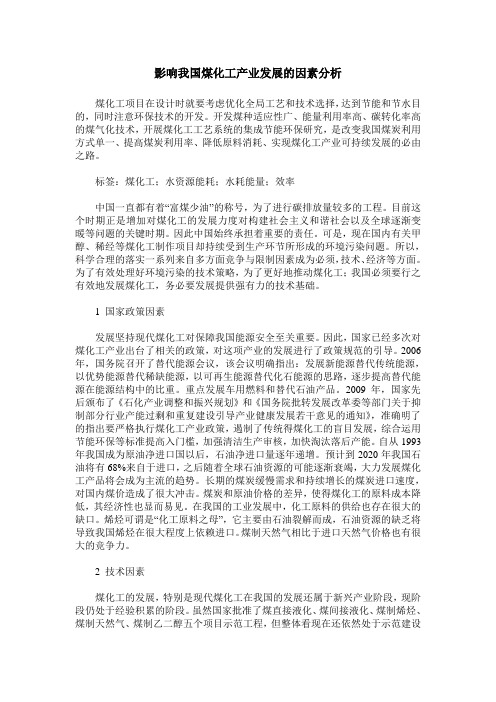
影响我国煤化工产业发展的因素分析煤化工项目在设计时就要考虑优化全局工艺和技术选择,达到节能和节水目的,同时注意环保技术的开发。
开发煤种适应性广、能量利用率高、碳转化率高的煤气化技术,开展煤化工工艺系统的集成节能环保研究,是改变我国煤炭利用方式单一、提高煤炭利用率、降低原料消耗、实现煤化工产业可持续发展的必由之路。
标签:煤化工;水资源能耗;水耗能量;效率中国一直都有着“富煤少油”的称号,为了进行碳排放量较多的工程。
目前这个时期正是增加对煤化工的发展力度对构建社会主义和谐社会以及全球逐渐变暖等问题的关键时期。
因此中国始终承担着重要的责任。
可是,现在国内有关甲醇、稀经等煤化工制作项目却持续受到生产环节所形成的环境污染问题。
所以,科学合理的落实一系列来自多方面竞争与限制因素成为必须,技术、经济等方面。
为了有效处理好环境污染的技术策略,为了更好地推动煤化工;我国必须要行之有效地发展煤化工,务必要发展提供强有力的技术基础。
1 国家政策因素发展坚持现代煤化工对保障我国能源安全至关重要。
因此,国家已经多次对煤化工产业出台了相关的政策,对这项产业的发展进行了政策规范的引导。
2006年,国务院召开了替代能源会议,该会议明确指出:发展新能源替代传统能源,以优势能源替代稀缺能源,以可再生能源替代化石能源的思路,逐步提高替代能源在能源结构中的比重。
重点发展车用燃料和替代石油产品。
2009年,国家先后颁布了《石化产业调整和振兴规划》和《国务院批转发展改革委等部门关于抑制部分行业产能过剩和重复建设引导产业健康发展若干意见的通知》,准确明了的指出要严格执行煤化工产业政策,遏制了传统得煤化工的盲目发展,综合运用节能环保等标准提高入门槛,加强清洁生产审核,加快淘汰落后产能。
自从1993年我国成为原油净进口国以后,石油净进口量逐年递增。
预计到2020年我国石油将有68%来自于进口,之后随着全球石油资源的可能逐渐衰竭,大力发展煤化工产品将会成为主流的趋势。
煤炭资源的枯竭

最大的煤炭消费国。2004年至2006年,我国煤炭 产量年均复合增长率达10.3%,2006年、2007年 上半年我国煤炭总产量分别为23.8亿吨和10.82亿 吨。受煤炭进出口税率变化、国内煤炭需求旺盛 和人民币升值影响,预计中国煤炭未来一定时期 内出口量进一步减少,进口量进一步增加。近年 来,我国沿海省份的煤炭需求量一直很大。但我 国约90%的煤炭资源和生产能力分布在西部和北 部地区。
如何解决煤炭资源枯竭?
1、能源基础地位不可动摇 煤炭是确保中国未来20年经济 可持续增长的战略资源,其经济价值将在未来稳步提高。 2、国家产业政策有利于煤炭行业的健康发展 国家不仅 确定了煤炭在我国基础能源的战略地位,而且指明了煤炭工 业发展方向,这将有利于我国煤炭行业长期健康、可持续发 展。 3、宏观经济的高速发展,为煤炭需求持续增长提供了可能 经济的高速发展、消费结构迅速升级、我国城市化水平迅速 提速,为煤炭行业发展创造了巨大的市场需求 4、技术创新为煤炭行业发展提供动力 现代科学技术的飞速发展为我国煤炭行业带来了无限生机, 随着煤炭工业技术水平的提高,一大批技术含量高、生产效 率高、经济效益好的现代化矿井先后建成投产,大大提升煤 炭行业整体生产水平,综合机械化采煤工艺成为煤炭开采主 流
3、运输:瓶颈长期存在中国煤炭运输呈现“西 煤东运”和“北煤南运”的格局。煤炭资源和需 求的地理分布不均衡使煤炭运输成为制约我国煤 炭行业发展的关键因素。虽然我国政府在增加铁 路运力方面做出了很大努力,并将对国有铁路系 统进行进一步扩能,但目前仍不能完全满足煤炭 运输的需要,运力短缺的局面在近期内仍然难以 得到根本性的改变。因而,使得拥有稳定而充足 的运输能力的煤炭公司具备了重要的竞争优势。
《煤炭产业政策》解读

长 的道 路 ,发 展 过 程 中还 存 在许 多突 出 问
题 。 为 了 解 决 这 些 问 题 ,从 2 0 0 5年 9月 开 始 . 国煤 炭 工 业 协 会 组 织 有 关 单 位 完 成 了 中 煤 炭 产 业 研 究 报 告 , 家 发 改 委 在 此 基 础 上 国
提 出了《 炭产业 政 策》 送 审稿 )报请 国务 煤 ( ,
《 炭产业 政策 》对 开办煤 矿 上 述 规 定 , 考 虑 了各 地 的 实 际 情 煤 既
和从事煤 矿建 设项 目设计 、施 工 、 况 , 又维 护 了国办 发[0 68 2 0 ]2号文 工 、 材 等 相关 产 业 , 建 为煤 炭 行 业
监理等提 出资质管理要 求 。 实施 开 通知 的严 肃性 , 于政策 在一 段 时 组 建 大 型 企 业 集 团 提 出 了 更 宽 阔 便
维普资讯
名ቤተ መጻሕፍቲ ባይዱ导论
《 煤炭产业政策》 解读
文/ 吟 吴
以保 障煤 炭稳定供 应 。 《 炭 产 业 政 策》 煤 的发 布 , 是继 《 国务 院 炭基地建设 开发 , 关 于 促 进 煤 炭 工 业 健 康 发 展 的若 干 意 见 》
( 发 [ 0 18号 ) 来 , 炭 工 业 发 展 史 上 国 2 51 0 以 煤
1 3
维普资讯
名家导论 f X E T F U P R OR M E
他条件 ” 。
模 ,煤 炭产业 政策 》 十五 条作 出 《 第
的发 展 不 仅 仅 局 限在 煤 炭 领 域 内 , 而 是 进 一 步 拓 展 到 电 力 、冶 金 、 化
一
成 部分 。发 布并 实施 《 炭产 业 政策 》 对 于 煤 ,
国家发改委发布《煤炭产业政策》(全文)
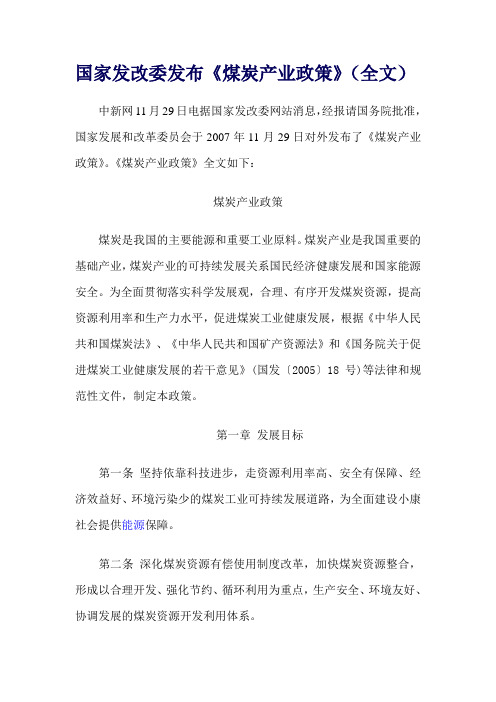
国家发改委发布《煤炭产业政策》(全文)中新网11月29日电据国家发改委网站消息,经报请国务院批准,国家发展和改革委员会于2007年11月29日对外发布了《煤炭产业政策》。
《煤炭产业政策》全文如下:煤炭产业政策煤炭是我国的主要能源和重要工业原料。
煤炭产业是我国重要的基础产业,煤炭产业的可持续发展关系国民经济健康发展和国家能源安全。
为全面贯彻落实科学发展观,合理、有序开发煤炭资源,提高资源利用率和生产力水平,促进煤炭工业健康发展,根据《中华人民共和国煤炭法》、《中华人民共和国矿产资源法》和《国务院关于促进煤炭工业健康发展的若干意见》(国发〔2005〕18号)等法律和规范性文件,制定本政策。
第一章发展目标第一条坚持依靠科技进步,走资源利用率高、安全有保障、经济效益好、环境污染少的煤炭工业可持续发展道路,为全面建设小康社会提供能源保障。
第二条深化煤炭资源有偿使用制度改革,加快煤炭资源整合,形成以合理开发、强化节约、循环利用为重点,生产安全、环境友好、协调发展的煤炭资源开发利用体系。
第三条严格产业准入,规范开发秩序,完善退出机制,形成以大型煤炭基地为主体、与环境和运输等外部条件相适应、与区域经济发展相协调的产业布局。
第四条深化煤炭企业改革,推进煤炭企业的股份制改造、兼并和重组,提高产业集中度,形成以大型煤炭企业集团为主体、中小型煤矿协调发展的产业组织结构。
第五条推进煤炭技术创新体系建设,建立健全以市场为导向、企业为主体、产学研相结合的煤炭技术创新机制,形成一批具有自主知识产权的行业重大关键技术。
培育科技市场,发展服务机构,形成完善的技术创新服务体系。
第六条强化政府监管,落实企业主体责任,依靠科技进步,以防治瓦斯、水、火、煤尘、顶板、矿压等灾害为重点,健全煤矿安全生产投入及管理的长效机制。
第七条加强煤炭资源综合利用,推进清洁生产,发展循环经济,建立矿区生态环境恢复补偿机制,建设资源节约型和环境友好型矿区,促进人与矿区和谐发展。
煤炭行业:传统能源的转型之路

《煤炭行业:传统能源的转型之路》一、行业规模与增长1. “1 个核心数据:行业总市场规模突破数万亿元大关”- 煤炭行业作为传统能源领域的重要组成部分,其市场规模庞大。
当前,煤炭行业总市场规模已突破数万亿元。
在近几年间,煤炭行业的发展呈现出复杂多变的态势。
一方面,随着全球经济的增长和工业化进程的推进,对煤炭等能源资源的需求持续存在,这在一定程度上支撑了煤炭行业的市场规模。
另一方面,受到环保政策趋严、新能源发展等因素的影响,煤炭行业也面临着诸多挑战。
- 煤炭行业市场规模增长的背后,有着多方面的驱动因素。
首先,能源需求的刚性支撑是重要原因之一。
在工业生产、电力供应等领域,煤炭仍然扮演着关键角色。
尤其是在一些发展中国家,工业化进程的加速使得对煤炭的需求持续增长。
其次,技术进步在煤炭开采和利用方面发挥了积极作用。
先进的开采技术提高了煤炭的生产效率和安全性,降低了生产成本。
同时,煤炭清洁利用技术的发展也为煤炭行业拓展了市场空间。
再者,国际市场的需求波动也对煤炭行业市场规模产生影响。
一些国家和地区对煤炭的进口需求变化,为煤炭出口国带来了市场机遇。
- 与同类型行业或相关行业相比,煤炭行业具有独特的发展潜力和地位。
与石油、天然气等能源行业相比,煤炭具有资源储量丰富、价格相对稳定等优势。
虽然在环保性能方面稍逊一筹,但在一些特定领域和地区,煤炭仍然是不可或缺的能源选择。
与新能源行业相比,煤炭行业在当前的能源结构中占据着重要地位,短期内难以被完全替代。
同时,煤炭行业也在积极探索与新能源的融合发展,以实现可持续发展。
2. “2 大增长引擎:技术创新与市场需求扩张”- 技术创新在煤炭行业的发展中起着至关重要的作用。
新产品的推出是技术创新的重要体现。
例如,新型煤化工产品的研发和生产,为煤炭行业带来了新的增长点。
通过煤炭深加工,可以生产出甲醇、烯烃等化工产品,提高了煤炭的附加值。
新工艺的应用也为市场带来了新的推动力。
如智能化开采技术的应用,提高了煤炭开采的效率和安全性,降低了人力成本。
“一优三减四化” 推动煤炭产业安全高效绿色发展

“一优三减四化”推动煤炭产业安全高效绿色发展1. 引言1.1 煤炭产业发展现状煤炭产业作为我国能源生产的重要组成部分,发挥着不可替代的作用。
随着我国工业化进程的加快,煤炭产业也取得了长足的发展。
截至目前,我国煤炭产量居世界首位,煤炭消费量也稳居全球前列。
随着社会经济的快速发展,煤炭产业也面临着一系列严峻挑战。
煤炭资源严重亏损。
由于长期过度开采和无序开采,我国煤炭资源面临严重枯竭的风险。
许多煤矿已经进入衰退期,煤炭质量也逐渐下降,给煤炭产业的可持续发展构成了严重威胁。
煤炭产业环境污染严重。
煤炭的燃烧会产生大量的二氧化硫、氮氧化物等有害气体,严重污染空气质量,影响人民生活健康。
煤炭开采和运输也会对地表和地下水资源造成污染,破坏生态环境。
煤炭产业在取得辉煌成就的同时也面临着多方面的挑战。
要推动煤炭产业安全高效绿色发展,需要加强安全管理、提高资源利用效率、降低环境污染排放,实现经济效益、社会效益和环境效益的有机统一。
【字数:278】1.2 煤炭产业面临的挑战煤炭产业面临着诸多挑战,其中包括环境污染、资源枯竭、安全生产等多方面问题。
煤炭开采和利用的过程中会产生大量的废气、废水和固体废物,对周围的环境造成严重的污染,影响了人们的健康和生活质量。
煤炭资源是有限的,随着煤炭需求的增加和开采的加剧,资源的枯竭日益加剧,给未来的能源安全带来了巨大的挑战。
煤矿事故频发,安全生产形势严峻,不仅造成人员伤亡和财产损失,还严重影响了煤炭产业的可持续发展。
面对这些挑战,煤炭产业必须转变发展方式,加强技术革新和管理创新,引入先进的安全生产理念和绿色发展理念,才能实现长期可持续发展。
2. 正文2.1 煤炭产业安全管理现状煤炭产业是我国基础产业之一,但也是一个高度危险的行业。
在煤炭生产过程中,安全管理是至关重要的一环。
目前,煤炭产业安全管理存在一些问题和挑战。
煤炭企业的安全意识不够强烈,很多企业对安全管理措施的实施不够到位,导致事故频发。
产业转移对河北省煤炭需求量的影响
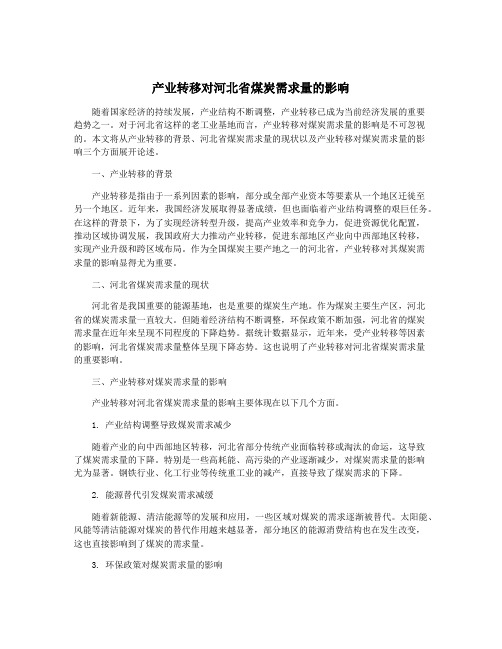
产业转移对河北省煤炭需求量的影响随着国家经济的持续发展,产业结构不断调整,产业转移已成为当前经济发展的重要趋势之一。
对于河北省这样的老工业基地而言,产业转移对煤炭需求量的影响是不可忽视的。
本文将从产业转移的背景、河北省煤炭需求量的现状以及产业转移对煤炭需求量的影响三个方面展开论述。
一、产业转移的背景产业转移是指由于一系列因素的影响,部分或全部产业资本等要素从一个地区迁徙至另一个地区。
近年来,我国经济发展取得显著成绩,但也面临着产业结构调整的艰巨任务。
在这样的背景下,为了实现经济转型升级,提高产业效率和竞争力,促进资源优化配置,推动区域协调发展,我国政府大力推动产业转移,促进东部地区产业向中西部地区转移,实现产业升级和跨区域布局。
作为全国煤炭主要产地之一的河北省,产业转移对其煤炭需求量的影响显得尤为重要。
二、河北省煤炭需求量的现状河北省是我国重要的能源基地,也是重要的煤炭生产地。
作为煤炭主要生产区,河北省的煤炭需求量一直较大。
但随着经济结构不断调整,环保政策不断加强,河北省的煤炭需求量在近年来呈现不同程度的下降趋势。
据统计数据显示,近年来,受产业转移等因素的影响,河北省煤炭需求量整体呈现下降态势。
这也说明了产业转移对河北省煤炭需求量的重要影响。
三、产业转移对煤炭需求量的影响产业转移对河北省煤炭需求量的影响主要体现在以下几个方面。
1. 产业结构调整导致煤炭需求减少随着产业的向中西部地区转移,河北省部分传统产业面临转移或淘汰的命运,这导致了煤炭需求量的下降。
特别是一些高耗能、高污染的产业逐渐减少,对煤炭需求量的影响尤为显著。
钢铁行业、化工行业等传统重工业的减产,直接导致了煤炭需求的下降。
2. 能源替代引发煤炭需求减缓随着新能源、清洁能源等的发展和应用,一些区域对煤炭的需求逐渐被替代。
太阳能、风能等清洁能源对煤炭的替代作用越来越显著,部分地区的能源消费结构也在发生改变,这也直接影响到了煤炭的需求量。
3. 环保政策对煤炭需求量的影响随着环保政策的不断加强和执行,燃煤产生的大气污染等环境问题日益引起重视。
- 1、下载文档前请自行甄别文档内容的完整性,平台不提供额外的编辑、内容补充、找答案等附加服务。
- 2、"仅部分预览"的文档,不可在线预览部分如存在完整性等问题,可反馈申请退款(可完整预览的文档不适用该条件!)。
- 3、如文档侵犯您的权益,请联系客服反馈,我们会尽快为您处理(人工客服工作时间:9:00-18:30)。
国家产业政策对煤炭工业的影响1The Effects on the Coal Industry by National Industrial Policies Abstract潘 克 西摘要:本文在系统论述中国建国以来国家煤炭产业政策发展变化的基础上,运用产业经济学理论和方法,分析、研究了国家产业政策对煤炭工业的作用和影响,论证了在不同时期国家采用两种完全相反的煤炭产业政策的必要性。
并在借鉴西方市场经济国家煤炭产业政策实践经验的同时,提出了中国目前和未来一段时间内煤炭工业产业政策的基本方向。
This paper expounds systematically the developing trends of national coal industrial policies after the foundation of PRC. Then, the functions and the effects on the coal industry by national industrial policies are studied and researched with economic theories and methods. The rationality of the two completely reversing policies in coal industry by our country during different periods is discussed. By using the practical experiences of national coal industrial policies in western countries with market economics with references, the basic directions of coal industrial policies are put forward at present and in the future for the government of China.正文:产业政策是政府将宏观管理深入到社会再生产过程之内,按照经济发展中资源配置结构进化的客观规律,依据本国的国情及其经济发展的阶段,对国民经济运行中的资源配置结构及其形成过程,进行科学的、系统的和适当的干预、介入和参与,从而达到提高国民经济整体效益和实现整体协调的目的,并寻求最大限度的经济增长和经济发展的经济政策。
产业政策的推行在西方市场经济国家已有近百年的历史了,而“产业政策”一词在中国官方文献中作为一系列的政府政策,只是近十几年的事情。
在此,笔者试图运用产业经济学理论和方法就1949年中国建国以来国家有关煤炭工业政策的形成、发展、演变及其作用和影响做一全面、系统的分析研究,以期在客观、认真地总结以往经验教训的基础上,寻求中国未来煤炭工业产业政策的基本方向。
一、中国煤炭产业政策的类型与形成背景1949年中国建国以来,国家对煤炭工业的政策总的来说可分为鼓励煤炭生产快速增长和限制煤炭盲目生产两种类型。
在计划经济时期,由于煤炭供不应求,为保障煤炭供应,国家对煤炭工业采取鼓励生产快速增长的倾斜政策;改革开放以后,特别是进入九十年代,煤炭供应紧张局势逐步缓解,并转而走向生产过剩,97年开始煤炭市场持续供大于求,因此,国家对煤炭生产采取关井压产、调整结构、平衡总量的限制性政策,以控制煤炭生产盲目增产。
(一)、鼓励煤炭生产快速增长的政策长期以来,煤炭工业在中国国民经济中始终占有举足轻重的地位,能源生产和消费都是以煤为主,在一次能源的生产和消费结构中,煤炭一直占总量的70%以上,特别是在五、六十年代,煤炭消费量甚至占到能源消费总量的80%~90%。
1本文中文在1999年世界华商管理大会上专题演讲,发表于《世界经济文汇》1999年第11期,英文在2000年第五届世界管理大会(加拿大)上专题演讲,并发表于大会论文集。
能源紧张,突出的表现就是煤炭供不应求。
建国以后,经过三年的经济恢复和“一五”到“五五”时期的大规模建设,中国工业化进程取得了巨大成就。
伴随这一进程,产业结构也发生了重大变化。
相对耗能低的农业、商业地位下降,耗能高的工业成为国民经济的主导部门。
工业结构中高耗能的钢铁、建材、化工等部门增长很快、地位提高,高耗能的产业结构也就是高耗煤的产业结构。
这种产业结构决定了煤炭工业的支柱性地位。
有学者曾就1952年到1988年期间煤炭增长和社会总产值增长进行线性回归,用数学回归方程清楚、准确地得出了两者互为需要、互相影响的关联度。
当煤炭产量为自变量,社会总产值为因变量时,计算结果为煤炭产量每增加一个百分点,社会总产值可增长1.2个百分点。
将两者变换位置后,计算结果为社会总产值每增加一个百分点,就要求煤炭增长0.74个百分点。
两个结果的测定系数高达0.9,表明方程较为可信。
从而也说明了煤炭对国民经济的决定性作用。
因此,煤炭供不应求就影响到国民经济的整体建设速度。
为尽快改变这一状况,中国政府制定了“以钢为纲,以煤保钢”和“煤炭工业是国家工业化的先行工业”的方针战略,并采取了一系列加快煤炭增长和促进煤炭节约的政策措施。
如:投资向煤炭工业倾斜、大力发展乡镇煤矿、建设五大露天煤矿、统配煤矿投入产出总承包,逐步调整和放开煤炭价格等等。
后来的事实表明,前两项政策对煤炭工业的迅速成长起到了关键性的作用。
1、国家投资向煤炭工业倾斜从1949年到1980年的三十多年时间里,中国处于计划经济时期,煤炭工业的建设与发展基本上依赖于国家的投资。
其间,在国有煤矿基建投资的总量中国家拨款所占比例分别为:“一五”时期的92%、“二五”时期的88%、“三五”时期的97%、“四五”和“五五”时期的85%。
而地方和企业自筹资金仅占总量的3%~15%。
当时虽然也允许社队集体投资办矿,但其所占比重微乎其微,其煤炭产量占全国煤炭生产总量的比重也很小,1949年为4%、1960年为5%、1970年为9%、1980年为18%。
国家实施投资向煤炭工业倾斜政策后,煤炭工业的基建投资得到了国家的优先安排,其增长速度也很快。
在1953年到1980年的二十七年时间里,国家对国有煤矿基建投资的总额由4.33亿元猛增到34.64亿元,年均增长8%以上。
使得煤炭工业的基建投资在各个计划时期均占到全国工业基建投资总额的12%左右,特别是1963年~1965年的三年调整时期,比重更高。
2、大力发展乡镇煤矿改革开放以后,国家对煤炭工业采取了“大中小煤矿并举”的鼓励性政策。
在继续加大国有煤矿投入、特别是加快国有重点煤矿建设的同时,大力发展乡镇小煤矿。
1983年初,国家放宽了办矿政策,鼓励农民开办小煤矿。
同年3月,国务院颁发了《关于加快发展乡镇煤矿的八项措施》等文件,倡导“有水快流”、“国家修路,群众办矿”。
1985年1月,国家又制定了“国家、集体、个人一齐上,大、中、小煤矿一起搞”的发展煤炭工业新方针、新战略,同时采取了一系列措施,以充分调动各方办矿的积极性。
如国家无偿划出可供开采的煤炭资源、发放低息贷款、对出省煤炭给予财政补贴等等。
许多产煤省、自治区地方政府也给乡镇煤矿各种鼓励和优惠政策,如优先调拨钢材、木材等紧缺材料、给予实物补助等等。
(二)、限制煤炭产量盲目增长的政策进入九十年代中、后期,社会对煤炭的需求严重不足、煤炭生产能力明显过剩、库存急剧增加,煤炭市场疲软、竞争无序,煤炭价格过低、拖欠煤款严重,加之乡镇煤矿盲目发展,特别是非法开采的小煤矿违章经营,严重了扰乱市场的正常秩序、侵犯了国有煤矿的正当权益。
进一步加剧了国有煤矿,特别是部分国有重点煤矿的困难,煤炭工业再度陷入困境。
为此,国家采取限制性的政策,控制煤炭产量盲目增长,保持煤炭供求总量平衡。
其主要做法有二,一是下放原煤炭工业部直属的全部94个国有重点煤炭企业;二是在下放国有重点煤矿的基础上,实行关井压产。
下放,主要是解决煤炭管理体制不顺的问题;关井,主要是解决煤炭总量过剩的问题。
二者是一个互相联系的有机整体,构成新时期的国家煤炭工业产业政策。
1、下放国有重点煤矿1998年7月,国务院正式下发了《关于改革国有重点煤矿管理体制有关问题的通知》,将国有重点煤矿全部下放给所在的二十个省、自治区和直辖市的地方政府。
地方政府统一领导和管理国有重点煤矿、国有地方煤矿和乡镇煤矿,缓解了原来中央和地方分级管理时,国有重点煤矿和地方煤矿在资源和市场等方面的矛盾,便于统一组织生产、安排运力和划分市场,为有效地控制煤炭产量的盲目增长奠定了基础。
2、关井压产、调整煤炭工业结构在促使煤炭产量快速增长的同时,小煤矿的大量发展也带来了一系列的负面影响。
主要表现为,技术装备和开采方法落后,生产安全伤亡事故多;回采率低,浪费资源、污染环境;低水平重复建设,非法、违法开采;不正当竞争,冲击破坏市场秩序。
从而导致煤炭供求总量失衡,行业整体经济效益下滑,严重危害煤炭工业的可持续发展。
小煤矿的盲目发展,无序竞争,已导致国有大矿生产能力不能充分发挥,经营遇到前所未有的困难。
截止1997年底,全国共有各类煤矿6.4万处,其中各类小煤矿就有6.1万处,占总数的93.8%。
美国年产煤炭10亿吨,却仅有2196个煤矿。
与先进产煤国家相比,我国煤矿数量多得惊人,是美国的30倍,俄罗斯的300倍,澳大利亚的700倍。
小煤矿发展过快、过滥,导致国有大矿能力大量闭置。
1997年,国有重点煤矿能力利用率仅为88%,富余能力高达9000万吨。
特别是进入1998年以后,国有重点煤矿60%左右的矿井不能正常生产,有些处于停产、半停产状态。
一些由国家投入巨资建设的现代化矿井,其技术装备优势和生产能力不能得到有效发挥,给国家造成极大的浪费。
据统计,1997年全国二十七个产煤省、自治区、直辖市中,各类小煤矿共产煤炭6.22亿吨,占当年全国煤炭总产量13.3亿吨的47%,成为煤炭供大于求的主要根源。
小煤矿盲目发展,而国有重点煤矿生产能力严重放空,这不仅造成煤炭工业结构上的不合理,也是导致煤炭总量过剩的重要原因,要保持煤炭供求总量基本平衡,实现煤炭工业结构的优化,就必须将小煤矿非法和不合理的、乱采滥挖的产量压减下来。
为此,国务院于1998年11月下发了《关于煤炭工业关井压产工作有关问题的通知》,并制定了一系列政策。
关井压产的目标是要关闭非法开采、布局不合理、乱采滥挖以及生产高硫煤的各类小煤矿2.58万处,压缩产量2.5亿吨。
确定这样一个目标的依据有二,一是按照煤炭市场的有效需求测算,压缩2.5亿吨产量就可以基本实现煤炭供求总量的平衡,解决总量过剩的问题;二是6.1万处小煤矿中,仅非法开采的就有5.12万处,再通过依法整顿煤炭生产经营秩序,关闭2.58万处是合理合法的,也是切实可行的。
